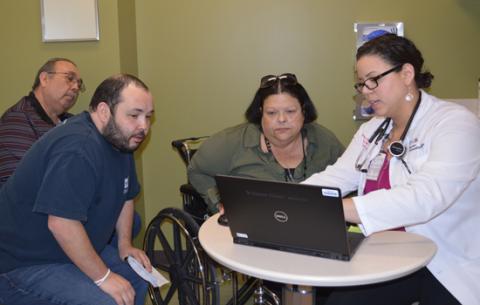About 12 years ago, Deborah Martinezwas admitted to Mt. Graham Hospital in Safford with pneumonia. “An echocardiogram showed I had heart disease, but it didn’t really affect me until about two years ago when I became really sick,” said Martinez. She has a genetic condition called hypertrophic cardiomyopathy, which leads to thickening of the heart muscle, often making the heart stiff and less able to relax and fill with blood.
Martinez, age 58, was hospitalized 5 times due to worsening advanced heart disease, often called heart failure. “I spent two months in the hospital during May and June (2017). I was given six months to live, but the cardiologists here saved my life,” said Martinez.

“The entire device is about two inches long - two wires that form a loop around a chip – and is implanted through the veins. From their homes, patients can record heart pressure measurements by simply lying down on a specially designed pillow. Information from the device is sent electronically and can be viewed by the patient care team online,” explained Nancy Sweitzer, MD, PhD, director of the UA Sarver Heart Center and chief of cardiology. In a recent clinical trial, CardioMEMS reduced hospital admissions by 37 percent.
"For me this has been life changing,” said Martinez, who had the device implanted in August 2017. “Since I have COPD (chronic obstructive pulmonary disorder) and heart disease, the doctors are not always sure whether they need to treat my heart or my lungs. I sometimes take steroids to control my COPD, which causes weight gain. I limit my sodium intake to 2 grams per day and my fluid intake to 2 liters to control my heart disease. When I’m sick it isn’t always clear if my symptoms are caused by my heart or lungs. CardioMEMS removes the guess work.”
Since the device was implanted, Martinez has received calls from Angelica Lentner, NP, an acute care nurse practitioner with Banner University Medical Center – Tucson, who monitors the patient data transmitted via the CardioMEMS system. “Angelica tells me whether to increase or decrease my diuretics, depending on the pressure in my lungs. It gives me tremendous peace of mind.” With better management of fluid levels, Martinez has been able to maintain a weight loss of 70 pounds.
Martinez enjoys an active life with her family, including her husband of 39 years, Frank, who recently re-proposed to her. They have two sons and several grandchildren. She enjoys hip-hop concerts, arts and crafts, and fishing and camping trips. “We’re planning a trip to Hawley Lake this summer and I need to figure out where I get cell service so I can take the CardioMEMS readings. I never miss a reading,” said Martinez.
One of America’s Silent Epidemics
The good news is more people are surviving heart attacks. The challenge this creates is the nearly 6.5 million Americans who are living with weakened hearts and experiencing heart failure, the only major cardiovascular disease on the rise, according to the Heart Failure Society of America. Currently there is no known cure for heart failure, however, recent scientific advances in treatment offer patients a more normal life expectancy.
The Advanced Heart Disease Team at University of Arizona Sarver Heart Center are building a biorepository to study unique patient characteristics of this hard-to-treat condition and pursuing clinical research to improve patient care. While a heart transplant may be the “gold standard” for heart failure, few people benefit from this option in large part because the supply of donor organs doesn’t match the need. That’s why the growth of heart failure and transplantation cardiology combined with cardiothoracic surgery has been such a priority at UA Sarver Heart Center.
Many Americans can significantly reduce their risk of heart failure if they have the information they need, know the questions to ask their health providers, and receive the support to make heart-smart changes in their lives.

